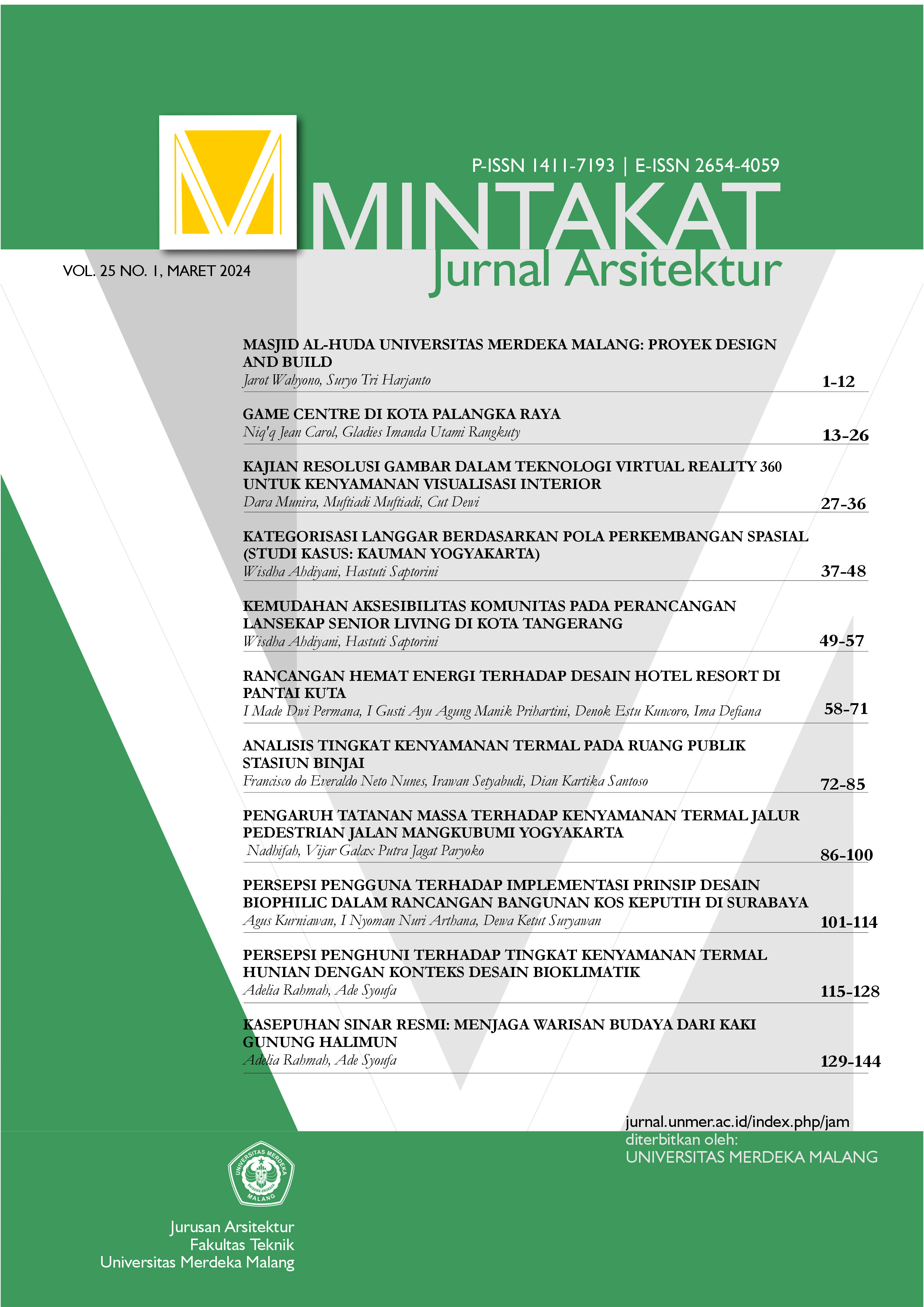Persepsi Pengguna terhadap Implementasi Prinsip Desain Biophilic dalam Rancangan Bangunan Kos Keputih di Surabaya
DOI:
https://doi.org/10.26905/jam.v25i1.11988Keywords:
Andy Rahman, Biophilic, Co-living, WorkplaceAbstract
Biophilic design principles emphasize the relation between human, nature, and building to improve the quality of built environment. Nowadays, the availability of communal space as workplace in co-living building has become a common need. In Surabaya, Andy Rahman is one of the architect who expresses his concern about this phenomenon by designing co-living building with workplace, while prioritize local design and natural system. The objects of this study are three co-living building that are designed by Andy Rahman, located in Keputih, Surabaya. This study aims to describe how users experience and perceive the elements of biophilic design within the objects of study case. This research implements qualitative strategy to examine user’s perception of biophilic design principles in the design of each co-living building. Qualitative methods purports to describe the real life conditions of research subject. The data are collected by observation and interviews. The participants consist of university students that each have lived in the study case building for at least a year. The analysis is carried using the theory of biphilic design patterns and interior elements of biophilic design. The results show that there is an incremental changes among the object of the study regarding the quantity of perceived aspect. However, the results show that all three building designs are dominated by the sampe aspects. Moreover, the results indicates that the participants have different abilities in associating each design parameterDownloads
References
Alexander, C., Ishikawa, S., Silverstein, M., Jacobson, M., Fiksdahl-King, I., & Angel, S. (1977). A Pattern Language. Oxford University Press.
Almusaed, A. (2011). Biophilic and Bioclimatic Architecture Analytical Therapy for the Next Generation of Passive Sustainable Architecture. In Biophilic and Bioclimatic Architecture. Springer. https://doi.org/10.1007/978-1-84996-534-7
Andy Rahman Architect. (n.d.). Andy Rahman Architect. Retrieved November 28, 2023, from https://www.andyrahmanarchitect.com
Ataman, C., & Dino, I. G. (2019). Collective Residential Spaces in Sustainability Development: Turkish Housing Units within Co-Living Understanding. IOP Conference Series: Earth and Environmental Science, 296(1). https://doi.org/10.1088/1755-1315/296/1/012049
Browning, W., Ryan, C., & Clancy, J. (2014). 14 Patterns of Biophilic Design: Improving Health & Well-Being in the Built Environment. Terrapin Bright Green, LLC, 1–60. https://doi.org/10.1016/j.yebeh.2008.04.024
Day, C., & Gwilliam, J. (2020). Living architecture, Living Cities Soul-Nourishing Sustainability. Routledge.
Groat, L., & Wang, D. (2013). Architectural Research Methods (Second Edi). John Wiley & Sons, Inc.
Indah, I., & Wardono, P. (2021). Co-living space: The shared living behavior of the millenial generation iin Indonesia. ARTEKS : Jurnal Teknik Arsitektur, 6(2), 199–214. https://doi.org/10.30822/arteks.v6i2.679
Lucas, R. (2016). Research Methods for Architecture. Laurence King Publishing Ltd.
McGee, B., & Park, N. K. (2022). Colour, Light, and Materiality: Biophilic Interior Design Presence in Research and Practice. Interiority, 5(1), 27–52. https://doi.org/10.7454/in.v5i1.189
Osborne, R. (2018). Best Practices For Urban Coliving Communities. Interior Design Program: Theses, 132.
Songsangyos, P., & Iamamporn, S. (2020). Remote Working with Work-life Balance. International Journal of Applied Computer Technology and Information Systems, 9(2), 85–88.
Zhao, J., Bentlage, M., & Thierstein, A. (2017). Residence, workplace and commute: Interrelated spatial choices of knowledge workers in the metropolitan region of Munich. Journal of Transport Geography, 62(November 2016), 197–212. https://doi.org/10.1016/j.jtrangeo.2017.05.012
Zhong, W., Schröder, T., & Bekkering, J. (2022). Biophilic design in architecture and its contributions to health, well-being, and sustainability: A critical review. Frontiers of Architectural Research, 11(1), 114–141. https://doi.org/10.1016/j.foar.2021.07.006














